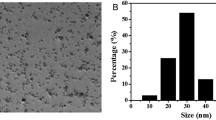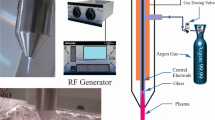Abstract
The morphology characteristics of cell apoptosis of the malignant tumour cells in magnetic field-treated mouse was observed for the first time. The apoptotic cancer cell contracted, became rounder and divorced from adjacent cells; the heterochromatin condensed and coagulated together along the inner side of the nuclear membrane; the endoplasmic reticulums (ER) expanded and fused with the cellular membrane; many apoptotic bodies which were packed by the cellular membrane appeared and were devoured by some lymphocytes and plasma. Apoptosis of cancer cells was detected by terminal deoxynucleotidyl transferase mediatedin situ nick end labeling (TUNEL). It was found that the number of apoptosis cancer cells of the sample treated by the magnetic field is more than that of the control sample. The growth of malignant tumour in mice was inhibited and the ability of immune cell to dissolve cancer cells was improved by ultralow frequency (ULF) pulsed gradient magnetic field; the nuclei DNA contents decreased, indicating that magnetic field can block DNA replication and inhibit mitosis of cancer cells. It was suggested that magnetic field could inhibit the metabolism of cancer cell, lower its malignancy, and restrain its rapid and heteromorphic growth. Since ULF pulsed gradient magnetic field can induce apoptosis of cancer cells and inhibit the growth of malignant tumour, it could be used as a new method to treat cancer.
Similar content being viewed by others
References
Poole, C., Extremely low frequency electric and magnetic fields and cancer, Cancer Causes Control, 1991, 2: 267–270.
Chen Jiasen, Eletromagnetic field and organism, Biomagnetism (in Chinese), 1997, 1: 6–8.
Chang Hanying, Li Guilan, Pan Yuming et al., Experimental observation on the effect of magnetic field on S-180 sarcomas in mice, Chinese Journal of Physics Medicine (in Chinese), 1985, 7(3): 169–170.
Chang Hanying, Li Guilan, Wang Guozhu et al., Primary report of 18 cases on magnetic field therapy for malignant tumour, in Biomedical Physics Study (in Chinese), Wuhan: Wuhan University Press, 1990, 74–75.
Zhou Wansong, Applied advance of magnetic field therapy for tumour, Chinese Biomagnetism (in Chinese), 1994, 8(2): 1–6.
Zhang Husheng, Ye Hui, Zhang Qingchuan et al., SEM and TEM observations on inhibitory effect of ultralow frequency pulse magnetic field on mice’s S-180 Sarcomas, Chinese Science Bulletin, 1995, 40(6): 512–516.
Zhang Husheng, Ye Hui, Zhang Qingchuan et al., Experimental studies on extremely low frequency pulsed magnetic field inhibiting sarcoma and enhancing cellular immune functions, Science in China, Ser. C, 1997, 40(4): 392–397.
Zhang Husheng, Jin Xiangrui, Ye Hui et al., Extremely low frequency pulsed magnetic field restrains cancer cells in animal and human, in Biomagnetism Study and Application (in Chinese), Beijing: Atomic Energy Press, 1994, 18–21.
Fang, M., Zhang, H. Q., Xue, S. B., Role of calcium in apoptosis of HL-60 cells induced by harring tonine, Science in China, Ser. C, 1998, 41(6): 600–607.
Silva, C. P., Oliveira, C. R., Lima, M. C. P., Apoptosis as a mechanism of cell death induced by different chemotherapeutic drugs in human leukemic T-lymphocytes, Biochem Pharmacol, 1996, 51: 1331–1340.
Ben-Sasson, S. A., Sherman, Y., Gaurieli, Y., Identification of dying cells by in situ staining, Methods Cell Biol., 1995, 46: 29–39.
Fang Fude, Forward Position Technology of Molecular Biology (in Chinese), Beijing: United Press of Beijing Medical University and Peking Union Medical University, 1998, 164–167.
Zhang Husheng, Magnetic field inhibits malignant tumour growth on the different biological levels, Academic Periodical Abstracts of China (in Chinese), 2000, 6(11): 1402–1403.
Song Jindan, Medical Cell Biology (in Chinese), Beijing: People’s Health Press, 1997, 212.
Zhang Husheng, Du Bi, Zhang Xinchen et al., Magnetic field inhibited sarcoma and discussion on the change of the membrane potentials, Journal of Wuhan University (Natural Science Edition) (in Chinese), 1998, 506–508.
Li Guodong, Zhou Wansong, Guo Liweng et al., Biomagnetism-Application, Technology and Principle (in Chinese), Beijing: National Defense Industry Press, 1993, 318, 309.
Author information
Authors and Affiliations
Corresponding author
Rights and permissions
About this article
Cite this article
Zeng, F., Zheng, C., Zhang, X. et al. Experimental studies on ultralow frequency pulsed gradient magnetic field inducing apoptosis of cancer cell and inhibiting growth of cancer cell. Sci. China Ser. C.-Life Sci. 45, 33–39 (2002). https://doi.org/10.1360/02yc9004
Received:
Issue Date:
DOI: https://doi.org/10.1360/02yc9004




